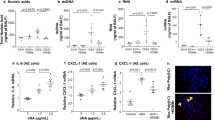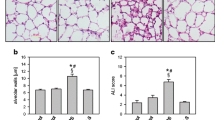Abstract
Intracellular pools of reduced sulfhydryl compounds are taxed in protective and repair processes during oxidant lung injury. To determine the efficacy of exogenous sulfhydryl compounds in preventing the toxic effects of high oxygen exposure on lung, the cell permeable sulfhydryl compounds, cysteamine (CYS) or N-acetylcysteine (NaC), were infused continuously in rats during exposure to 1 atm O2. CYS caused a reduction in mortality compared to vehicle treated-oxygen exposed rats at seven days (56% vs 78% respectively). At 48 hours, CYS reduced oxidant-induced pulmonary edema, measured by wet to dry weight ratios, and prevented oxidation of lung nonprotein sulfhydryls. NaC was even more effective in reducing mortality compared to vehicle treated-oxygen exposed rats (28% vs 78% respectively). In contrast to this beneficial effect of sulfhydryl compounds in oxygen toxicity, oxidant injury due to paraquat poisoning was exacerbated. Mortality increased in mice and rats given paraquat and treated with CYS. We speculate that this effect may be due to the ability of paraquat to accept reducing equivalents directly from CYS, thereby increasing reactive oxygen generated from reduced paraquat.
Similar content being viewed by others
References
Ameer B, Greenblatt DJ (1977) Acetaminophen. Ann Intern Med 87:202–209
Bacq ZM, Herve A (1955) Protective action of ingested cysteamine against X-irradiation. Compt Rend Soc Biol 149:1509–1512
Boyd MR, Stiko A, Statham CN, Jones RB (1982) Protective role of endogenous pulmonary glutathione and other sulfhydryl compounds against lung damage by alkylating agents. Biochem Pharmac 31:1579–1583
Currie WD, Gelein RN, Sanders AP (1973) Comparison of protective agents against hyperbaric oxygen in large animals. Aerospace Med 44:996–998
De Lucia AJ, Mustafa MG, Cross CE (1972) Ozone interaction with rodent lung I. Effect of sulfhydryls and sulfhydryl-containing enzyme activities. J Lab Clin Med 80:559–566
De Lucia AJ, Mustafa MG, Hussain MZ, Cross CE (1975) Ozone interaction with rodent lung III. Oxidation of reduced glutathione and formation of mixed disulfides between protein and nonprotein sulfhydryls. J Clin Invest 55:794–802
DeMarco C, Grayiani MT, Mosti R (1966) Spectrophotometric determination of thiols and disulfides with N-ethylmaleimide. Anal Biochem 15:40–44
Deneke SM, Gershoff SN, Fanburg BL (1983) Potentiation of oxygen toxicity in rats by dietary protein or amino acid deficiency. J Appl Physiol: Resp Environ Exercise Physiol 54:147–151
Eldjarn L (1965) Some biochemical effects of S-containing protective agents and the development of suitable SH/SS systems for thein vitro studies of such effects. Prog Biochem Pharmacol 1:173–185
Eldjarn L, Nygaard O (1954) Cystamine—Cysteamine: Intestinal absorption, distribution among various organs and excretions. Arch Int Physiol 62:476–486
Gershman R, Gilbert DL, Caccamise D (1958) Effect of various substances on survival times of mice exposed to different high oxygen tensions. Am J Physiol 192:563–571
Gershman R, Nye SW, Gilbert DL, Dwyer P, Fenn WO (1954) Studies on oxygen poisoning. Protective effect ofβ-mercaptoethylamine. Proc Soc Exp Biol Med 85:75–77
Gilbert HF (1982) Biological disulfides: the third messenger? J Biol Chem 257:12086–12091
Griffith OW, Meister A (1979) Translocation of intracellular glutathione to membrane bound γ-glutamyl transpeptidase as a discrete step in the γ-glutamyl cycle. Proc Natl Acad Sci U.S.A. 76:268–272
Haberle D, Wallander A, Sies H (1979) Assessment of the kidney function in maintenance of plasma glutathione concentration and redox state in anaesthetized rats. FEBS Lett 108:335–340
Haugaard N (1968) Cellular mechanisms of oxygen toxicity. Physiol Rev 48:311–373
Hinson JA, Pohl LR, Monks TJ, Gillette JR (1981) Acetaminophen-induced hepatotoxicity. Life Sciences 29:107–116
Holme JA, Wirth PH, Dybing E, Thorgeirsson SS (1982) Modulation of N-Hydroxyparacetamol cytotoxicity in suspensions of isolated rat hepatocytes. Acta Pharmacol et Toxicol 51:96–102
Jamieson D (1965) Effect of cysteamine, cyanide, and high pressure oxygen on splenic oxygen tension and sulfhydryl content. Nature 207:541–542
Jamieson D, Van Den Brenk HAS (1962) Pulmonary damage due to high pressure oxygen breathing in rats. Changes in dehydrogenase activity of rat lung. Aust J Exp Biol Med Sci 40:51–56
Keeling PL, Smith LL (1982) Relevance of NADPH depletion and mixed disulphide formation in rat lung to the mechanism of cell damage following paraquat administration. Biochem Pharmac 31:3243–3249
Keeling PL, Smith LL, Aldridge WN (1982) The formation of mixed disulfides in rat lung following paraquat administration. Biochem et Biophys Acta 716:249–257
Kimball RE, Reddy K, Pierce TH, Schwartz LW, Mustafa MG, Cross CE (1976) Oxygen toxicity: augmentation of antioxidant defense mechanisms in rat lung. Amer J Physiol 230:1425–1431
Levine WG (1982) Glutathione, lipid peroxidation and regulation of cytochrome P-450 activity. Life Sciences 31:779–784
Massey RE, Racz WJ (1981) Effects of N-acetylcysteine on metabolism, covalent binding, and toxicity of acetaminophen in isolated mouse hepatocytes. Tox Appl Pharm 60:220–228
Matkovics B, Barabas K, Szabo L, Berencsi G (1980)In vivo study of the mechanism of protective effects of ascorbic acid and reduced glutathione in paraquat poisoning. Gen Pharmac 11:455–461
Matkovics B, Barabas K, Varga SI, Szabo L, Berencsi G (1982) Some new data to the toxicological effects of paraquat and the therapy. Gen Pharmac 13:333–341
McArn GE, Gee SJ, Krieger RI, Lim LO, Ross JG (1980) Ascorbic acid potentiated pathologic and toxicologic effects of paraquat and n-propyl viologen in rats. Proc Soc Tox 19th Ann Meeting, Washington D.C., p A101
Meister A, Anderson ME (1983) Glutathione. Ann Rev Biochem 52:711–760
Montgomery MR, Furry J, Gee SJ, Krieger RI (1982) Ascorbic acid and paraquat: oxygen depletion with concurrent oxygen activation. Toxicol Appl Pharmacol 63:321–329
Mundy RL, Heiffer MH, Leifheit HC (1961) Blood and urine sulfhydryl and disulfide levels after large doses ofβ-mercapoethylamine or cystamine. Rad Res 14:421–425
Mustafa MG, Tierney DF (1978) Biochemical and metabolic changes in lung with oxygen, ozone, and nitrogen dioxide toxicity. Am Rev Respir Dis 118:1061–1090
Nagamatsu K, Kido Y, Terao T, Ishida T, Toki S (1982) Protective effect of sulfhydryl compounds on acute toxicity of morphinone. Life Sciences 30:1121–1127
Patterson CE, Rhodes ML (1982) The effect of superoxide dismutase on paraquat mortality in mice and rats. Toxicol Appl Pharmacol 62:65–72
Revesz L, Modig H (1965) Cysteamine-induced increase of cellular glutathione-level; a new hypothesis of radioprotective mechanism. Nature 207:430–431
Rhodes ML, Patterson CE (1979) Chronic intravenous infusion in the rat: a nonsurgical approach. Lab Anim Sci 29:82–84
Schatte C, Swansinger A (1976) Effect of dietary “antioxidant” supplementation on the susceptibility to oxygen toxicity in mice. Aviat Space Environ Med 47:147–150
Sokal RR, Rohlf FJ (1969) inBiometry, Freeman and Co., San Francisco, California, p. 235–246.
Sorbo B (1962) The effect of radioprotective agents on tissue nonprotein sulfhydryl and disulfide levels. Arch Biochem Biophys 98:342–344
Szabo S, Trier JS, Frankel PW (1981) Sulfhydryl compounds may mediate gastric cytoprotection. Science 214:200–202
Thor H, Moldeus P, Orrenius S (1979) Effect of cysteine, N-acetylcysteine, and methionine on glutathione biosynthesis and bromobenzene toxicity in isolated rat hepatocytes. Arch Biochem Biophys 192:405–413
Waechter JM, Faiman MS (1982) Glutathione and nonprotein sulfhydryl in cerebral cortex and lung in mice exposed to high oxygen pressure. Toxicol 23:213–221
Author information
Authors and Affiliations
Rights and permissions
About this article
Cite this article
Patterson, C.E., Butler, J.A., Byrne, F.D. et al. Oxidant lung injury: Intervention with sulfhydryl reagents. Lung 163, 23–32 (1985). https://doi.org/10.1007/BF02713803
Accepted:
Issue Date:
DOI: https://doi.org/10.1007/BF02713803




